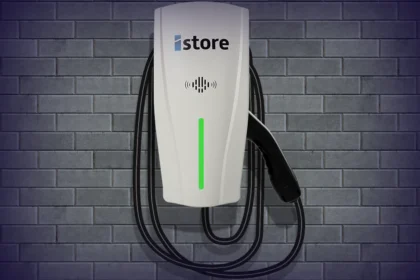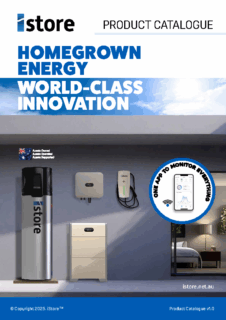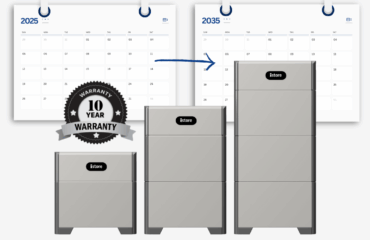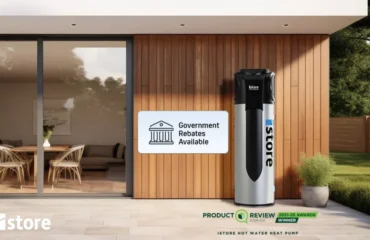
So, you’ve made the switch to an electric vehicle (EV), or you’re seriously thinking about it. Excellent! EVs are quiet, clean, and cheaper to run: no petrol stops, no oil changes, just smooth rides and lower bills.
But driving electric is only half the story. The real game-changer? Charging at home. No more fighting for a spot at the local charging station or waiting around while your battery crawls from 20% to “almost there.” With an EV wall charger, your garage becomes your personal recharging station: fast, smart, and convenient.
How can you choose the right EV wall charger for your car, home, and lifestyle?
This iStore guide will tell you everything you need to know!
What Is an EV Wall Charger and How Does It Work?
An EV wall charger is a device that lets you charge your EV from home using your household power supply. You can mount it on a wall in your garage, carport, or driveway.
All EVs come with a basic charger, often called a Level 1 charger. This charger plugs into a standard power point, like your toaster or phone charger would. But it’s quite slow, taking 12–20 hours, or even longer, to fully recharge your EV’s battery.
Alternatively, Level 2 chargers are dedicated wall units that use a higher voltage to deliver power much faster. Depending on your home’s electrical setup, a Level 2 charger can fully charge your EV in 4–10 hours.
Most EV wall chargers connect directly to your home’s switchboard, drawing power through a dedicated circuit.
Many EV wall chargers, like iStore’s are part of a solar energy product lineup, letting you charge your car using free, clean energy from the sun. Some systems can even prioritise solar energy first, so you’re not drawing from expensive grid electricity unless you need to.
How to Choose an EV Wall Charger: Key Factors to Consider
Charging Speed
Charging speed refers to how fast your EV wall charger can add power to your EV’s battery. The higher the charging speed, the less time you need to plug in your EV.
Charging speed is measured in kilowatts (kW). A higher kW rating means faster charging. For example, a 7.2 kW Level 2 charger can typically add around 30 to 50 km of range per hour, depending on your vehicle. Compare that to a basic 2.4 kW Level 1 charger, which only adds 10 to 15 km of range per hour.
You must check how much power your EV can accept. Some vehicles cap out below 7.2 kW, so going for a higher-powered charger won’t necessarily speed things up.
Compatibility
You must also check how much power your home can handle. Most single-phase homes in Australia can support chargers up to 7.2 kW. Larger properties with a three-phase power supply can support chargers up to 22 kW. iStore’s EV chargers are available in either 11kW or 22kW so you can select the one most suitable for your home.
Choose a charger that delivers the maximum speed your home and EV can support, without overpaying for power you can’t use.
Then, there’s the plug. Not all EVs use the same plug. The EV wall charger you choose must match your vehicle’s connector. Most newer EVs use a Type 2 connector, which has become the standard. However, some older models or imports might use a Type 1 connector instead.
Check your EV manual or speak to your dealer before buying. Many chargers list which vehicle brands or connector types they support, so it’s usually easy to confirm.
Smart Features
Some EV wall chargers like iStores, come with smart features. One of the most useful is app control. With a connected app, you can start or stop charging from your phone, check how much charge your car has, or get alerts when it’s done.
Energy monitoring lets you see exactly how much electricity your EV uses, which is handy for tracking energy usage costs and managing your home’s overall energy usage.
Scheduling is another great feature. You can set your charger to only run during off-peak hours when electricity is cheaper.
Some chargers are demand response ready, meaning they can automatically adjust charging during peak times if your electricity provider offers incentives. It’s a way to help balance the grid and lower your electricity bills.
Many chargers can also connect to smart home systems like Google Home or Amazon Alexa, so you can manage charging with voice commands or automate it as part of your home energy routine.
If you like convenience, control, and saving money, it’s worth looking for an EV wall charger with these smart features.
Durability and Safety
Your EV wall charger must be able to handle Aussie weather if you’re installing it outdoors. Choose a weatherproof model that resists rain, heat, and dust. Most chargers including iStore’s list an IP rating (like IP65), which shows how well the unit keeps out water and dirt. A higher number means better protection.
Safety is also important. A good EV charger should have built-in protections against overheating, short circuits, and power surges. These features help prevent damage to your car and home, especially during storms or power outages.
Check for certifications that show the charger has been tested to meet Australian safety standards. Look for things like RCM (Regulatory Compliance Mark) or other recognised approvals so you know you’re buying a reliable product.
Aesthetics
While performance matters most, the look of your EV wall charger is not to be overlooked, especially if it’s mounted in a visible spot like your driveway or garage wall.
Some chargers have a sleek, modern design that will blend in with your home’s exterior, while others might stand out more than you’d like. Many brands also offer compact units with clean lines and neutral colours that won’t clash with your space.
If visual appeal matters to you, take a moment to check the size, shape, and finish of the charger before buying.
Benefits of Installing an EV Wall Charger at Home
Convenience
Having a wall charger at home means you can plug in your EV when you get home and wake up to a full battery.
No trips to a public charger, no waiting in line, no wasting time. Just easy, reliable charging on your schedule.
Cost Savings
Charging your EV at home is often much cheaper than using public charging stations. Public chargers usually charge higher rates per kilowatt-hour, and some add session or connection fees.
With a home EV wall charger, you can also take advantage of off-peak electricity rates, which are lower prices charged by your energy provider when demand is low (late at night or early in the morning). Many chargers let you schedule charging to start during these hours automatically, so you save money without lifting a finger.
Energy Efficiency
Pairing your EV wall charger with solar panels is incredibly energy efficient. Instead of drawing electricity from the grid, your charger can use the free energy your solar system produces during the day. If you also have a solar battery, you can store any extra generated solar energy and use it to charge your EV at night, maximising your solar savings.
This setup means you rely less on grid electricity, especially during peak times when prices are higher. You can charge your EV for next to nothing!
Using solar energy to charge your EV also helps reduce your carbon footprint with clean, renewable power instead of coal or gas-generated energy.
Resale Value
An EV wall charger can make your home more appealing to future buyers as more people switch to electric vehicles. For EV owners, having a charger already installed is a big plus, saving them the cost and hassle of installing one.
EV Charger Comparison
| Feature | Level 1 Charger | Level 2 Charger |
|---|---|---|
| Power Output (kW) | Approx. 2.4 kW | 3.6–7.2 kW (single-phase) / up to 22 kW (3-phase) |
| Voltage | 230–240 V (standard outlet) | 230–240 V (dedicated circuit) |
| Home Compatibility | Single-phase | Single-phase and 3-phase |
| Charging Speed | Slow | Fast |
| Charging Time | 12–20+ hours (full charge) | 4–10 hours (single-phase) / 1.5–4 hours (3-phase) |
| Range Added per Hour | 10–15 km | 30–50 km (single-phase) / up to 120 km (3-phase) |
| Installation | Simple; plugs into a standard power point. Comes with a wall bracket or hook for easy mounting | A licensed electrician must safely connect the charger to the switchboard and meet Australian electrical standards |
| Smart Features | None | Often includes app control, timers, and usage data |
| Best For | Occasional or low-mileage users | Daily charging, faster top-ups, solar integration |
| Solar Compatibility | Limited | Can integrate with solar systems |
| Cost | Typically included for free with an EV purchase | Higher (equipment + installation) |
EV Charger Incentives and Rebates Available in Australia
Some Australian state and territory governments offer incentives for installing residential EV chargers.
In the Australian Capital Territory, eligible homeowners can get a loan from $2,000 to $15,000 to buy energy-efficient products, including electric vehicle charging infrastructure. This is a zero-interest loan, and homeowners have up to 10 years to repay it.
Over in the Northern Territory, the EV Charger Grants Scheme offers a $1,000 grant to EV owners for purchasing and installing a home charger.
Federal and state-based incentives for installing solar batteries can help make solar EV charging more accessible and affordable for Australians.
Starting July 1, 2025, the federal Cheaper Home Batteries Program offers up to a 30% reduction in the cost of home solar batteries, potentially saving households up to $18,600 or 30% off the cost of a home battery.
Various states provide additional incentives. For example, New South Wales offers up to $2,400 off the installation cost of a solar battery for homes and businesses with existing solar.
How Much Does an EV Wall Charger Cost?
Most EVs come with a basic Level 1 charger. But if you want faster charging, you’ll need a dedicated Level 2 charger.
Level 2 EV wall chargers can range from $500 to $3,000. Installation, including labour and materials (wiring, circuit breakers), can cost between $700 and $1,500. So you can usually expect to pay $1,500-4500 for a Level 2 charger and installation.
How to Install an EV Wall Charger
Installing a Level 1 EV wall charger doesn’t require professional help. Simply plug the charger straight into a standard household power point. You can then mount the charger on a wall using a basic wall bracket or cable hook, which is often included or easy to buy separately.
Installing a Level 2 charger is more involved and must be done by a licensed electrician.
They will
- Inspect your switchboard and wiring. The electrician will check whether your switchboard can handle the extra load of an EV wall charger. They’ll look at your existing circuit breakers, wiring condition, and whether you have single-phase or three-phase power. Your switchboard may need an upgrade or a new circuit breaker installed.
- Plan and run a dedicated circuit. EV chargers require their own circuit, separate from other appliances. The electrician will run new cabling from your switchboard to the charger location. They’ll choose the safest and most direct route, avoiding interference with existing wiring or plumbing.
- Install a safety switch (RCD). A residual current device (RCD) must be installed to protect against electric shock or faults. This is a legal requirement in Australia.
- Mount the charger on the wall. Once the wiring is in place, the charger is mounted securely onto a solid surface using manufacturer-provided brackets. The location should be sheltered (if possible), easily accessible, and within reach of your EV’s charging port.
- Connect and test the system. The electrician will connect the charger to the power supply, test for faults, and make sure the unit complies with Australian safety standards (AS/NZS 3000). They’ll also issue a Certificate of Compliance, which confirms they performed the installation safely and legally.
- Integrate the charger with your solar system. If you have solar panels, the electrician can configure your EV wall charger to draw energy from your solar system when available. Some chargers also support solar optimisation features, which prioritise charging from solar over the grid. If you have a solar battery, your setup can be expanded to store daytime solar energy and use it for overnight EV charging.
Common Installation Challenges and How to Overcome Them
- Outdated Switchboards: Some older homes have switchboards that can’t handle the extra load of an EV charger. If yours is outdated, an electrician may need to upgrade it by adding a new circuit breaker or replacing the entire board. While this adds to the upfront cost, it’s a one-time upgrade that improves overall electrical safety in your home.
- Limited Meter Box Space: If your meter box is already full, there may not be room to add the dedicated circuit your charger needs. In this case, your electrician might install a sub-board or rearrange the layout to make space.
- Long Cable Runs: If your charger needs to be installed far from the switchboard, like at the end of a long driveway, this can increase the cost and complexity. Longer cable runs may require heavier-duty wiring to maintain performance, so it’s a good idea to choose the most direct and practical location for the charger, if possible.
- Outdoor Mounting Issues: If you’re installing the charger outside, it must be weatherproof and mounted securely. Harsh sun, rain, and dust can damage unprotected units. Look for chargers with a high IP rating (e.g. IP65), and make sure your installer places it in a sheltered area or uses a weatherproof enclosure.
- Strata or Apartment Restrictions: If you live in an apartment or unit, you might need body corporate approval before installing an EV wall charger. Some buildings also have limited electrical capacity or shared infrastructure, so check with your strata manager before making any plans.
Planning ahead and working with a licensed electrician will help you spot these issues early and find the right workaround, so you can get charging faster with fewer surprises.
How to Maintain Your EV Wall Charger
Regular care will help your EV wall charger run smoothly and safely for longer.
- Wipe the charger and cable regularly with a dry or slightly damp cloth to remove dust, dirt, and cobwebs. Avoid using harsh chemicals or high-pressure water.
- Check the charger, plug, and cable for cracks, frayed wires, or signs of damage. If anything looks worn out or loose, stop using the charger and contact your installer or manufacturer for advice.
- Check that the cable plugs in and out smoothly and the charger feels secure on the wall. If the cable is difficult to connect or the unit feels loose, a minor adjustment or servicing may be needed.
- If your EV takes much longer to charge or the charger frequently stops mid-session, there may be an issue with the hardware or the connection to your switchboard. These are signs that servicing is required.
- If you notice unusual sounds, heat, or error messages, call a licensed electrician or the charger’s support team. It’s better to check it early than risk damaging your car or electrical system.
- Many smart chargers receive software updates that improve performance or add new features. Use the app (if available) to check for updates every few months. Staying up to date helps your charger run more efficiently and keeps it compatible with future EV models or energy systems.
How to Future-Proof Your EV Charging Setup
Look for an EV wall charger that supports various charging speeds and connector types, so it’ll still work if you upgrade to a different EV down the track. Some chargers can be adjusted or reconfigured as needed, so you won’t have to replace the whole unit when changing cars.
Smart chargers that receive firmware updates are another good choice. These updates improve performance, fix bugs, and sometimes add new features without needing a new device. Updates are usually managed through the charger’s app.
If you plan to add more electrical appliances to your home, such as an electric water heater or stovetop, choose an EV charger with dynamic load management. This feature automatically balances power use across your home, so the charger doesn’t overload your system.
Why Choose iStore for Your EV Wall Charger?
iStore is a proud Australian-owned company. Our local expertise and customer support help us deliver EV charging solutions tailored to your driving habits and expectations, as well as to Aussie road and weather conditions.
Here’s what our EV chargers have to offer.
- Quality: Durable and weather-resistant.
- Safety: Built-in safety features to protect your home and vehicle.
- Compatibility: Works with various EV models, including popular Australian EVs.
- Competitive Pricing: Affordable without compromising on performance or safety.
- Sustainability: Supports environmentally-friendly EV charging, reducing your reliance on fossil fuels.
- Smart Charging Technology: Schedule charging times to coincide with off-peak electricity hours, control and monitor charging sessions, and integrate with your solar system, all from your smartphone.
- Integration With iStore Solar Energy Systems: If you have an iStore hybrid inverter and solar battery as part of a solar energy system, your iStore EV charger will seamlessly work with them to maximise energy efficiency and electricity savings.
FAQs
What Is the Best EV Wall Charger for Home Use?
The best EV wall charger is one that suits your electric vehicle, matches your home’s power supply, and offers the right balance of speed, smart features, and integrates into your solar and battery system.
How Fast Does an EV Wall Charger Charge a Car?
The Level 1 charger that comes with an EV can take 12–20 hours, or even longer, to fully recharge the EV’s battery. Alternatively, Level 2 chargers use a higher voltage to deliver power faster. Depending on the home’s electrical setup, a Level 2 charger can fully charge an EV in 4–10 hours.
Do I Need a Wall Charger for My EV?
A wall-mounted EV charger gives you a neat, secure, and dedicated spot to power up your EV at home. It’s more convenient than using a public charging station because there are no queues, no wait times, and no detours.
Do I Need a Single-Phase or Three-Phase EV Charger?
Most homes in Australia use single-phase power, which supports chargers up to 7.2 kW—enough for overnight charging. If your home has three-phase power, you can install a faster charger (up to 22 kW), but your EV must support three-phase charging to benefit.
How Much Does It Cost to Install an EV Wall Charger?
Most EVs come with a basic Level 1 charger that plugs into a standard power point. But if you want faster charging, you’ll need a dedicated Level 2 charger.
Level 2 EV wall chargers can range from $500 to $3,000. Installation, including labour and materials (wiring, circuit breakers), can cost between $700 and $1,500. So you can usually expect to pay $1,500-4500 for a Level 2 charger and installation.
Upgrade Your EV Charging with iStore
Wondering how to choose an EV wall charger?
Wonder no more! This guide covers everything you need to know, from charging speed and compatibility with your EV and your home’s electrical setup to installation costs and maintenance.
Don’t choose just any EV wall charger; choose the best EV wall charger in Australia from iStore.
Our chargers are high in quality and safety, generous in warranty (10 years!), and affordable in price.
Have questions? Need advice or a quote? Get in touch by calling 1300 515 640 or filling out this online form. Our EV charger experts are ready to help!




